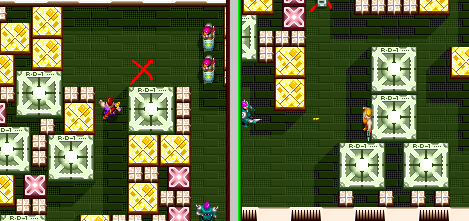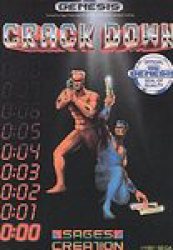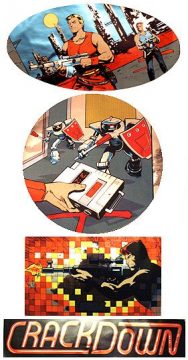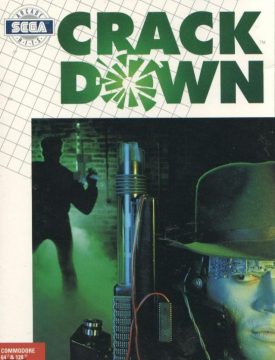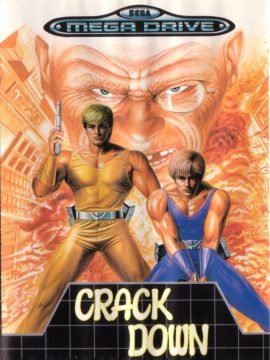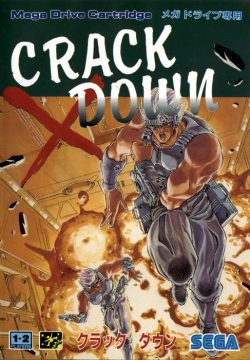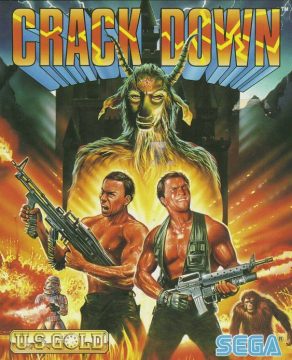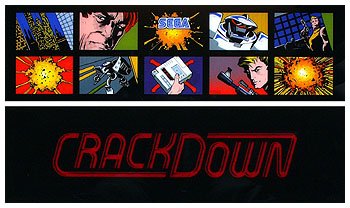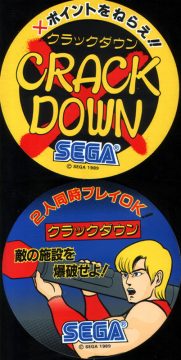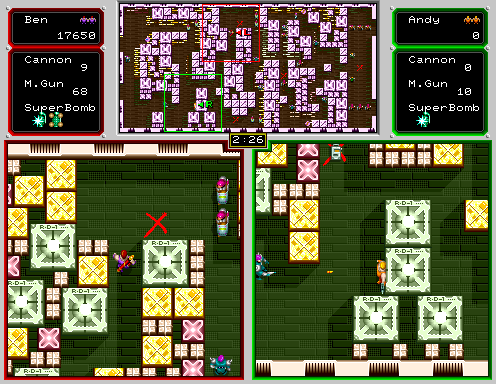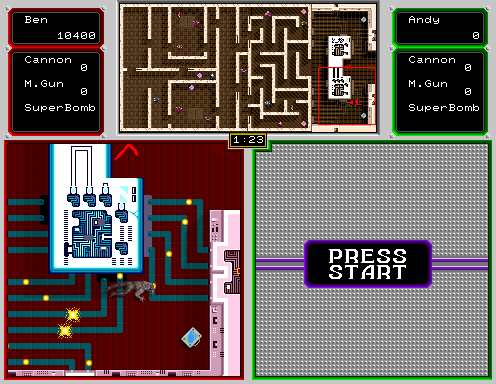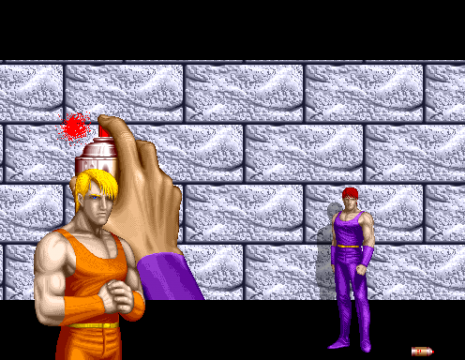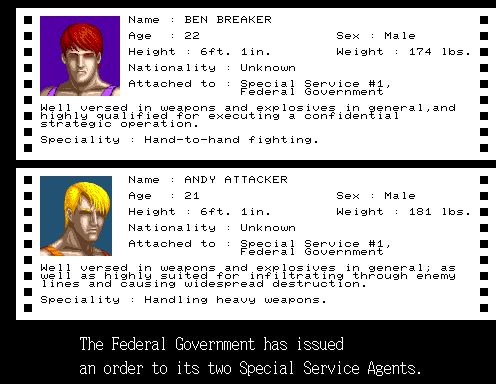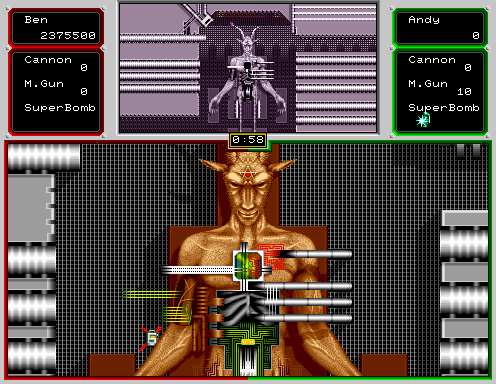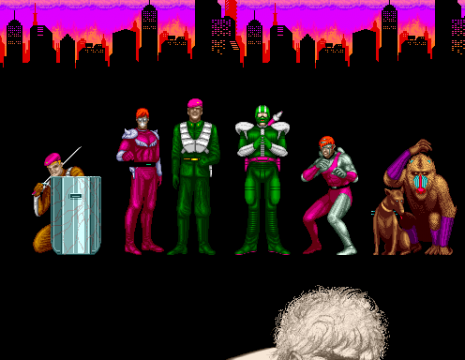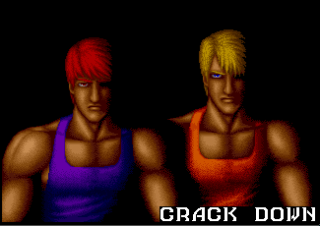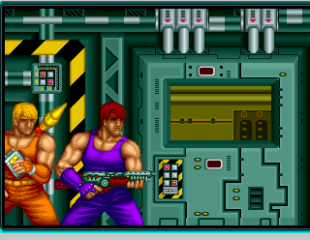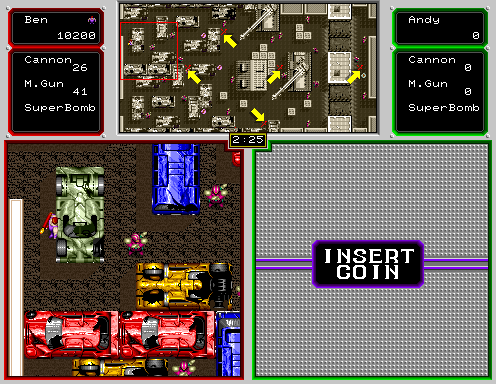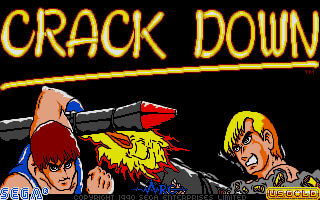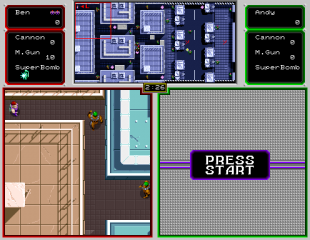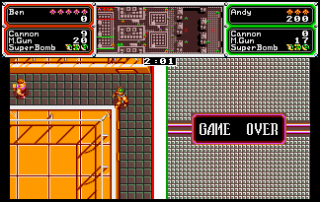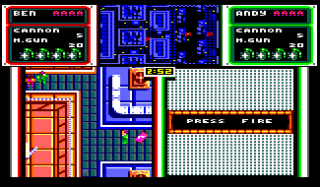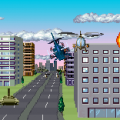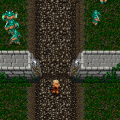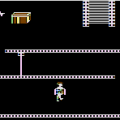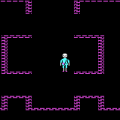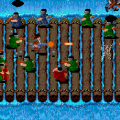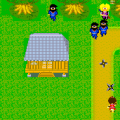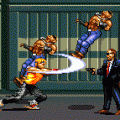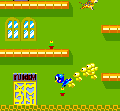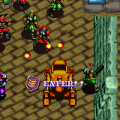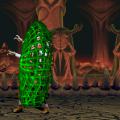Crack Down (no relation to the 2007 Xbox 360 game) is a unique two player action game that emphasizes strategy and cooperation. In some ways, it’s similar to Gain Ground. Both run on Sega’s slightly obscure System-24 board, utilizing some fairly nice high res (496×384) graphics. And both are overhead action games that rely more on strategy and cooperation than standard run and guns like Commando or Mercs. It was designed by Yutaka Sugano, who had devised Crack Down as sort of an overhead take on his previous arcade game, Shinobi.
While Crack Down doesn’t quite have the depth of Gain Ground, it’s still a pretty cool game. Your job, as one of two secret agents named Ben Breaker and Andy Attacker, is to infiltrate the headquarters of a mad scientist who is apparently bent on world destruction by creating a huge cybernetic goat demon. Each stage is sort of a mini-maze, where you need to plant a number of bombs, marked with large red Xs, and then hightail it to the exit. (The intro says that these are some “new type of bomb”, but never actually explains what’s so new about them.) Although there’s a time limit in each stage, all of the Xs are clearly marked on the map at the top of the screen, and you’re given more than ample time to clear each stage without getting too stressed out.
One of Crack Down‘s oddest design choices is making the map take up the entire half of the screen, while the bottom half is divided even further – player one in the lower-left window, player two in the lower-right. In other words, the action only really takes place in a quarter of the screen’s real estate, which feels unnaturally claustrophobic. And yet, once you get used to it, it actually works, since the map also shows the exact location of each and every enemy, as well as any weapon power-ups. It’s pretty clear that the game is designed for two player co-op, since the separate screens allow each player to individually cover each level, instead of being confined in the same screen.
This in turn creates a whole bunch of new strategies. Crack Down is less of a run-and-gun, and more of a stalk-and-gun, if one were to create a label for it. It’s not exactly a stealth game like Metal Gear, since the emphasis is clearly on killing bad guys instead of avoiding them, but you’re rewarded for playing it smart, especially because you don’t get any hugely powerful weapons. The obvious strategy is to try to sneak up on stationary bad guys to avoid their fire, or simply avoid enemy patrols, but you can also, say, use a door to block enemy shots, then return fire as the door shuts. Most of the action takes place in narrow corridors, and your characters can lean against the wall to dodge bullets, pop back out and fire return shots. If you can manage to get your enemies to shoot each other, you’ll actually be awarded double points. A lot of these tactics work much better when you’re playing with another person, but it’s serviceable in single player mode too.
You have two types of guns – your standard pistol, and rockets, which can take out a whole row of enemies. Although your ammo is limited, you can use melee attacks at close range, and there are several types bombs to kill all of the enemies on the screen, even accompanied by digitized yell, similar to Shinobi. Ammo restocks are heavily distributed throughout each stage. Most enemies are simple drones wielding guns, but eventually you come across some nasty guys with flamethrowers, and in one level, crazed baboons.
There aren’t technically any bosses, but there are a few “special” rooms at the end of each area. One includes endlessly spawning enemies; another is an electric grid. Normally you respawn right where you died, but in these area, you’re required to make it through these areas without dying, as you respawn at the beginning of the section. The final stage is a series of obstacles controlled by the mad professor, none of which ultimately work because they’re all action-focused in a game that isn’t really designed for it. It also requires that you’ve stockpiled enough ammo, because it’s required for the final segment.
On the surface it might be hard to appreciate the visuals, but there are a bunch of subtle (and not so subtle) touches. For starters – the awesome intro. The attract screen is a closeup of a hand spraying the Crack Down logo in graffiti against a decaying brick way. The cinematic when you actually start the game, viewed from a security camera as our heroes make an explosive entrance – is equally as impressive, even though the brightly colored spandex worn by the heroes doesn’t exactly jive. The graphics in-game might be small, but even though each stage has a unifying look and feel, the tilesets are completely unique for each of the sixteen stages. Some stages include warehouses, furnaces, junkyards, laboratories, each unique in its own way. The close-ups whenever you place a bomb, complete with the ticking counter, are remarkably cool. There are some cool details to make out, too, like the billboard advertising for “Prayboy”, which seems like an Engrish mangling until you see it’s a religious magazine.
And while there are only a few songs that repeat over and over, what’s there is fantastic. This make sense, considering master maestro Yuzo Koshiro contributed to the soundtrack. FM synth also tends to produce some pretty rad organ-like sounds, which adds to the sense of foreboding. Also, at the end of the game, your characters set explosives around the gigantic goat demon seen in the intro, and displayed prominently on some of the box artwork. The thing looks cool, but it’s disappointing that you don’t actually get to fight it or anything.
Crack Down isn’t Sega’s best, yet its unique and slightly offbeat dodge-and-shoot mechanics make it worth looking into. The Genesis port, released in North America by Sage’s Creation, is pretty faithful to the arcade game, at least from the gameplay perspective. However, since the resolution needed to be downgraded, most of the sprites end up looking cheap, and everything is even smaller than the arcade version. At least the second player window is now used to detail all of the enemies in the level when you’re playing alone, so it’s not quite wasted screen real estate anymore. The characters move faster, which is good, but there’s so much slowdown, even in single player, that it really negates any of the benefits.
Whenever you place a bomb, you just get a close-up of the ticking timer, without the little animation of the hand putting it in place. It’s a minor detail, but it’s not nearly as dramatic. This is also missing from the PC versions too. The map just shows the level layout and the Xs, while the enemies are just reduced to blips, so you can’t see which direction they’re facing, and you can’t see item pickups either.
The IBM PC, Amiga, and Atari ST ports are all pretty similar. The graphics, while not as colorful nor as detailed, are closer to the arcade game, and they play a bit faster too. There’s also a small control quirk that ends up working in its favor. When you’re lying against the wall and fire a shot, you’ll automatically jump out of cover and then back to safety. In the arcade and Genesis versions, you’ll stay prone and end up firing a useless shot along the wall which won’t hit anything. The sound isn’t quite as good as the arcade or Genesis versions (especially the DOS one), and the cinemas are no longer animated, but otherwise these are probably the best of the bunch.
The Commodore 64 version lacks music, and has some really awkward scrolling making it hard to see what’s in front of you. It also has a similar quirk when ducking against the wall, except instead of jumping out of cover, you’ll just fire straight into the wall, making it more or less completely useless. The Amstrad version is a bit better – it’s more colorful although still ugly, but the excessive slowdown and iffy collision detection really hurt it.
The Genesis version is also available on the Wii Virtual Console, and as part of the Sega Genesis Classic Collection Gold and individual download for PC.
